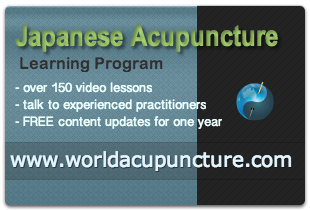One of the great pleasures of practicing Japanese Acupuncture is the amazing diversity of application of this modality.
I never cease to be amazed by the clinical efficacy of Traditional Japanese Acupuncture/Meridian Therapy.
Last week Tessa, Zoe and Isla, grandmother, mother, granddaughter/daughter attended clinic together to enable Zoe to receive treatment.
 3 generations, Tessa,Isla and Zoe
3 generations, Tessa,Isla and Zoe
Tessa was on hand to look after her granddaughter whilst her daughter received treatment.
During our preamble, Tessa revealed that her five month old granddaughter, Isla had been suffering from constipation for more than a week and that both mother and grandmother were becoming increasingly concerned about Isla’s condition.
As a result of that conversation I volunteered to give Isla treatment whilst her mother rested during the second phase of her treatment when the back-shu points were in place.
 Shonishin instruments, they look harsh but are applied with great gentleness and sensitivity
Shonishin instruments, they look harsh but are applied with great gentleness and sensitivity
Using my hands and shonishin instruments as pictured I applied gentle vibration primarily along the gallbladder meridian from the buttocks to the ankle, secondarily along the stomach meridian on her leg. I also applied a very gentle kneading technique to her tiny buttocks.
To balance these very gentle dispersive techniques on the gallbladder and stomach Meridian’s, I used the palm of my hand to warm the yin aspect of her lower leg.
Two days after the treatment I received this message from Tessa.
‘ Hi Alan, just to let you know that Isla has been to the loo several times since her visit!’
Therein lies yet another reason why I love going to work, I consider it a great privilege to practice Traditional Japanese Acupuncture/Meridian Therapy and I remain extremely grateful to Masakazu Ikeda sensei for his inspiration, commitment and guidance regarding the clinical diversity and power of Traditional Acupuncture.
Hope all is well in your world.
Kind regards,
Alan
Alan Jansson is an internationally recognized teacher and practitioner of Traditional Japanese Acupuncture. For well over a decade, independent of and in conjunction with Masakazu Ikeda sensei and Edward Obaidey, Alan has presented, convened and hosted more than 40 Traditional Japanese Acupuncture workshops in Australia, New Zealand and USA. Driven by a strong desire to promote the consumer friendly nature, clinical efficacy and potency of Meridian Based Traditional Japanese Acupuncture, Alan is a staunch advocate of practically based workshops and draws upon his 25 years clinical experience and 14 years post and undergraduate teaching in a concerted effort to lift the bar globally in the clinical application of this most amazing medical art.
Join him in Exploring the Art of Acupuncture in the 21st century at http://www.Worldacupuncture.com

Taht’s really great see. People tend give drugs to treat young children in this generation. I’m totally against it. I agree that acupuncture is the best way to treat symptoms like in this case. And Japanese acupuncture is very gentle so children will be more comfortable.
Thank you Takashi, appreciate your comment very much.
You might like to check out Dr. Subhassh’s comment on this post also.
Kind Regards,
Alan
Dear Dr.Alan,Thank You for sharing the Japanese Acupuncture Treatment for paediatric constipation.I am a med.doctor & a med.acupuncturist.I see quite a no:of constipated children.Your Japanese.Acup.Rx is great—we need not give laxatives,etc.When looking for the cause of the problem—I find it is due the way the children are feed(milk,nestum,etc.).If one follows the recomended milk powder& water ratio(small scoop-2+water2 oz)most babies develop GIT problems.To confirm this–to note 3 items related to the stools:(1)No:of times stools passed per day(1,2,3 times).If more–then there is a problem,if BO 2to3 or4 days once–then there is a problem.
(2)to not if the stools are firm,very soft or watery—then there is a problem.
(3)Very immportant–1&2 are OK–but the stools very foul smelling—-All these will mean that the bowels(large intestine) has a ptoblem—-WHY?because of what has gone through the mouth(feedings).When that aspect is also looked into+the Japanese Acup.Rx–the child would be long free of the GIT problems.AS for treatment your procedure is great.Thanks a Million for sharing(freely) knowedge.
Dear Dr. Subhassh,
Thank you for your awesome reply to my blogpost.
I really appreciate your feedback and am very grateful for your illuminating insights and positive comments.
We are in the very early stages of creating a truly global website at http://worldacupuncture.com and welcome your interest and commitment to better health.
Please feel free to join us as we ‘Explore the Art of Acupuncture in the 21st Century’ whenever you feel it to be appropriate.
Once again thank you for your interest, inspiration and commitment.
Kind Regards,
Alan
I would love to learn more about what we can do for these new little ones that grace us with thier unconditional love. Would you be interested in doing a work shop on pediactic?
I hope to be able to make the weekend workshop at the gabba, look forward to seeing you them.
Thanks Nadja,
I very much appreciate your positive feedback.
Hope to see you on the weekend, we can discuss Pediatric Workshop then if you like.
Lotsa,
Alan